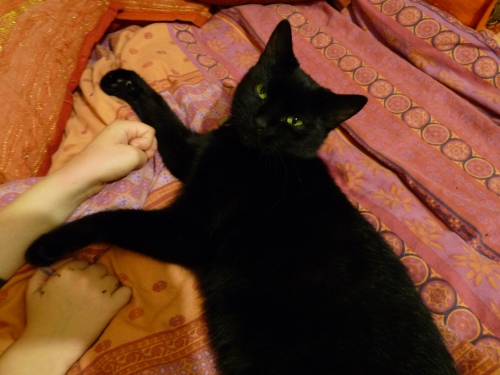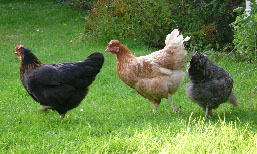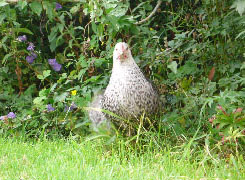Before the Shire Book of the Month, currently Pigs, changes, I want to tell you about a local meat producer called Waterloo Cottage Farm and the important role that small producers have in selling good meat from happy animals.
Meat is expensive and so it should be. To produce good meat takes time, through slow fattening on the right kind of food, fresh air and exercise for the animals, slaughter in the least stressful way possible followed by a decent period of hanging before it finally arrives in your kitchen.
With this in mind, I visited local producer Waterloo Cottage Farm in Great Oxenden, Northamptonshire and was given a tour of the farm by owner, Kirsty Clarke. We met in the light, cool shop, where a mouth-watering array of meat and produce was displayed. After a brief chat about what I wanted to see, I was taken out through the back door to the business end of the enterprise.
I was confronted by lots of open pens, with several different types of pigs enjoying the sunshine. I was wearing a long skirt and strappy sandals, so I tucked my skirt into my knickers and prepared to meet the pigs and what a gorgeous crew they were. I have a big soft spot for pigs at the best of times, but being able to climb into the pens and actually scratch them and talk to them was a treat indeed.
And Kirsty did indeed talk to her pigs and her care and enthusiasm for the creatures came across loud and clear. The farm has a herd of British Saddlebacks which are allowed to mature fully in the fields and woods which surround Waterloo Farm, as well as Petrans and Ginger Durocs. I became extremely soppy when she introduced me to the piglets who were running and rolling with their mother in the straw.
 The Clarkes also have lamb and hogget, chickens, ducks and geese and they select beef and veal from local farms who also use traditional breeds. All the animals have something in common. They are all reared using traditional, sustainable farming methods which work with nature, not against it. The animals are free to lead full, natural lives on healthy soil and fed on natural, local feed and the pigs are slow grown until they are 9-10 months which is a significantly longer life than an intensively bred animal. The barley comes from the farmer next door and the slaughterhouse is only nine miles away, the animals being accompanied there in a quiet and unstressed way which is better for the animal and better for the resulting meat.
The Clarkes also have lamb and hogget, chickens, ducks and geese and they select beef and veal from local farms who also use traditional breeds. All the animals have something in common. They are all reared using traditional, sustainable farming methods which work with nature, not against it. The animals are free to lead full, natural lives on healthy soil and fed on natural, local feed and the pigs are slow grown until they are 9-10 months which is a significantly longer life than an intensively bred animal. The barley comes from the farmer next door and the slaughterhouse is only nine miles away, the animals being accompanied there in a quiet and unstressed way which is better for the animal and better for the resulting meat.
 Looking at the meat in the shop is a very different experience to browsing the chiller aisles in the supermarket. The meat is darker in colour and more wholesome-looking than perhaps we’re used to and the bacon and sausages sit in great piles, pleading with you to take them home. The bacon and hams are cured on the premises and their master butcher produces fresh piles of traditional and artisan varieties of sausages every day.
Looking at the meat in the shop is a very different experience to browsing the chiller aisles in the supermarket. The meat is darker in colour and more wholesome-looking than perhaps we’re used to and the bacon and sausages sit in great piles, pleading with you to take them home. The bacon and hams are cured on the premises and their master butcher produces fresh piles of traditional and artisan varieties of sausages every day.
I bought some bacon and something I haven’t eaten for over thirty years – veal. I have deliberately avoided veal because of the unspeakable practice of veal crating, but with the sure knowledge that the animal that provided this had been happy, healthy and natural, I took a chop home and had it for my supper.
I can honestly say that I’ve never tasted meat like it; it was tender, sweet and juicy and so flavourful I could have wept. I also had some of their dry cured bacon for my breakfast the following morning and, apart from the taste, the most obvious difference was visual. No white scum stickily coating the bottom of your frying pan here, and two rashers and a couple of fried eggs was distinctly more filling that the abominable mid-range stuff you buy at the supermarket.
Local producers do an incredible job of farming. Not only do they help to preserve the rare breeds but they also help to preserve the very land on which they’re reared because of the sustainable ways in which they farm. The meat hasn’t travelled huge distances and is therefore beneficial to the environment in a wider sense. They are also firm protagonists of old skills such as proper butchery and artisan methods of preparation and, because of the renewed interest in this kind of food, many farms are taking on apprentices. Waterloo Cottage Farm also runs meat craft courses to encourage you to get the best out of their meat.
We must support these local producers in their endeavours by shopping with them whenever we can. I have said it before and I will keep saying it until you do as you’re told; eat less, eat better. Learn how to use to meat to get the best out of it and, I am convinced that properly reared, slow grown meat actually fills you up more so you don’t need as much of it. Eat less, eat better. It’s better for all of us.


















